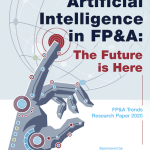The result is this paper that covers the elements crucial for any organisation approaching AI or ML for the first time including challenges, methods...

Modern finance is in flux, propelled forward by technological breakthroughs and a thirst for more refined analytics. Among the several technologies causing ripples in the industry, Artificial Intelligence (AI) has shown immense promise in reimagining Financial Planning and Analysis (FP&A).
In this article, we talk about two of the most prominent applications of AI in the realm of FP&A: forecasting and digital twins.
The Modernisation of Forecasting
Forecasting in FP&A is paramount to business strategy, decision-making, and risk management. Traditionally, this involved manual extrapolation of historical data, often falling prey to human biases and simplistic linear projections.
By utilising AI, businesses can analyse vast datasets at unprecedented speeds, incorporating countless variables previously deemed insignificant or too cumbersome to process. With the aid of Machine Learning (ML), predictive models self-improve over time, capturing nuances and adjusting to new trends, market shifts, and economic indicators. As a result, FP&A professionals can get a forecast that's not only more accurate but also adaptive to the ever-changing business environment.
In FP&A, forecasting is used for a variety of purposes, including:
- Budgeting: to create budgets, which are plans for how much money a company will spend and earn in the future.
- Resource allocation: to decide how to allocate resources, such as people, money, and equipment.
- Risk management: to identify and assess risks to the business. This information can be used to develop plans to mitigate these risks.
- Decision-making: to make decisions about various matters, such as pricing, marketing, and product development.
The following points provide a high-level overview of how an FP&A function could implement forecasting with the help of different AI/ML tools.
Data Collection and Objectives
Gather function-specific historical data and define clear forecasting objectives, such as projecting sales figures for the sales department or evaluating campaign ROIs for marketing.
Choose and Apply a Model
Depending on the data's nature, choices may range from time series for trend-based forecasting and causal models for assessing influencing factors to Machine Learning models for advanced pattern recognition.
- Technological Solutions
Modern cloud platforms offer robust tools to enhance forecasting:
- Google Cloud: Tools like AutoML Tables facilitate building and deploying Machine Learning models, while BigQuery ML allows the creation and execution of these models using SQL.
- Azure: Azure Machine Learning offers a comprehensive suite for constructing, training, and rolling out predictive models. Additionally, Azure Cognitive Services provide pre-built AI capabilities.
- Amazon SageMaker: SageMaker streamlines the process of building, training, and deploying Machine Learning models at scale. Its intuitive interface and pre-built algorithms make it a powerful tool for FP&A forecasting.
Integration
Once the model is crafted, integrate it with existing systems to ensure consistent data flow and real-time analytics.
Integrate broader business insights
Include information from related departments and external factors, such as macroeconomic shifts, to fine-tune forecasting accuracy.
Review and Refinement
- Continuously compare predicted figures with actual results. Understand deviations, refine models accordingly, and adjust strategies.
- Share forecast insights across related functions and with the central FP&A team, fostering alignment and cross-functional collaboration.
Harnessing Digital Twins in Financial Scenarios
Digital twins, which are virtual replicas of processes, products, or services, are increasingly making their mark in a range of sectors, especially when combined with AI. Within FP&A, digital twins provide a powerful tool for simulating various financial scenarios. It allows businesses to strategise in a sandbox environment, offering a pivotal advantage in risk management by visualising potential outcomes of diverse financial decisions.
The Boston Consulting Group describes digital twins as follows1:
"A digital financial twin helps companies meet the management requirements arising from these developments. A twin precisely allocates financial and nonfinancial information to products, sections of the value chain, or organisational units (including divisions, customer segments, and markets). This allocation is made possible, first, by the expansion of classification attributes for data and, second, by the availability of modern in-memory databases that combine such attributes to aggregate data in real-time."
Banks can utilise digital twins to augment their risk management strategies. By constructing digital representations of its trading operations and loan portfolio, the bank can now run simulations on the impacts of varied market events, from interest rate changes to shifts in currency exchange rates. This innovation provides their risk management team with a detailed landscape, guiding them in more calculated capital allocation and risk mitigation decisions.
Manufacturing firms can integrate digital twins to optimise their production processes. By replicating factories and production lines in a virtual space, companies can explore diverse production scenarios, considering potential changes in product mix or fluctuating demand patterns. This digital insight aids the production team in making judicious decisions about production schedules and the best allocation of resources.
Retailers can develop virtual models of their distribution centres and warehouses in the retail arena, where inventory management is paramount. It will allow them to simulate different inventory policies and assess the impacts of alterations in reorder points or lead times. Such a sophisticated approach ensures that the inventory team can consistently strike a balance between stock availability and efficient resource use, significantly enhancing operational efficiency.
Real-Life Case Studies Showcasing AI in FP&A
Egencia
By employing AI and Machine Learning, Egencia has revolutionised the domain of travel bookings and expense management2. Their system, adept at identifying optimal flights, hotels, and cost-effective car rentals, coupled with efficient expense tracking, has reportedly saved them over a million work hours annually.
Coca-Cola
To address the ubiquitous challenge of customer retention, Coca-Cola harnesses AI to predict customer churn3. By analysing data points like purchase history and online interactions, they identify customers potentially on the brink of departing. Their proactive measures, powered by AI, have reportedly led to a 5% reduction in customer churn.
Bank of America
The banking giant utilises AI to ensure transactional integrity and thwart fraudulent activities4. By analysing diverse data like payment history and IP addresses, the bank has quickly detected anomalies. Their AI-driven efforts have allegedly saved them from potential fraud losses of over a billion dollars.
Siemens
For Siemens, AI is instrumental in elevating their financial reporting5. By employing AI, they've developed interactive dashboards that FP&A professionals use to discern financial trends and make informed decisions. Siemens credits AI for a marked 10% improvement in their financial forecast accuracy.
Hilton Hotels
Prioritising customer satisfaction, Hilton Hotels leverages AI to offer a bespoke guest experience6. They curate personalised recommendations for rooms, eateries, and activities by analysing previous bookings and digital footprints. Hilton's AI initiatives have reportedly enhanced guest satisfaction rates by 5%.
Conclusion
Implementing AI in Financial Planning & Analysis (FP&A) presents distinct challenges alongside its advantages. A primary concern is the quality and integration of data, as inconsistent or fragmented data can lead AI models astray, especially when coupled with integration difficulties from legacy or disparate systems.
Skill gaps in traditional FP&A teams necessitate upskilling existing staff or hiring AI specialists. Both are resource-intensive solutions. The inherent complexity of advanced AI models can create a "black box" effect, often causing scepticism among stakeholders.
Moreover, an over-reliance on AI might overshadow valuable human insights. There are also significant cost implications for AI deployment, encompassing technology, training, and maintenance expenses.
Regulatory and compliance considerations are paramount, especially with the increasing scrutiny of financial forecasting tools. Lastly, Change Management, scalability, and ethical concerns, such as potential biases in AI forecasts, further complicate the AI integration with FP&A.
However, AI's pervasive influence in FP&A is not merely a technological evolution but a strategic revolution. The advanced forecasting techniques brought about by AI pave the way for proactive decision-making rooted in data-driven insights.
These advancements, complemented by real-world applications, emphasise the transformative potential of AI. As businesses globally continue to harness AI's capabilities, FP&A stands to become a bastion of precision, foresight, and agility, fostering a future where finance is not just managed but also envisioned with unparalleled clarity.
The list of references
- Boston Consulting Group. "Why Your Company Needs a Digital Financial Twins" (by Marc Rodt, Patrick Weber, Stefan Paetzold, and Bernd Weissenmayer). October 5, 2022. URL: https://www.bcg.com/publications/2022/why-companies-need-digital-financial-twins
- Egencia. "AI and ML: Travel tech companies facilitating corporate travel". May 19, 2023. URL: https://www.egencia.co.uk/en/tech-travel-companies-ai-machine-learning
- Emerj. "Artificial Intelligence at Coca-Cola – Two Current Use-Cases" (by Megan Jarrell). July 19, 2021. URL: https://emerj.com/ai-sector-overviews/artificial-intelligence-at-coca-cola/
- Bank of America. "Artificial Intelligence…Is Intelligent!". URL: https://business.bofa.com/en-us/content/ai-trends-impact-report.html
- Siemens. "AI and ML Design Resources". URL: https://eda.sw.siemens.com/en-US/trending-technologies/artificial-intelligence-machine-learning/
- GlobalData. "Hilton Worldwide Holdings Inc (HWHI) – Digital Transformation Strategies". June 27, 2022. URL: https://www.globaldata.com/store/report/hilton-worldwide-holdings-inc-enterprise-tech-analysis/
Subscribe to
FP&A Trends Digest

We will regularly update you on the latest trends and developments in FP&A. Take the opportunity to have articles written by finance thought leaders delivered directly to your inbox; watch compelling webinars; connect with like-minded professionals; and become a part of our global community.






